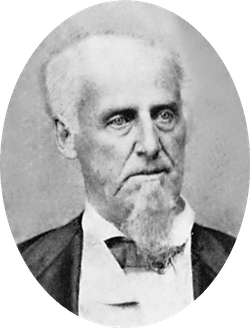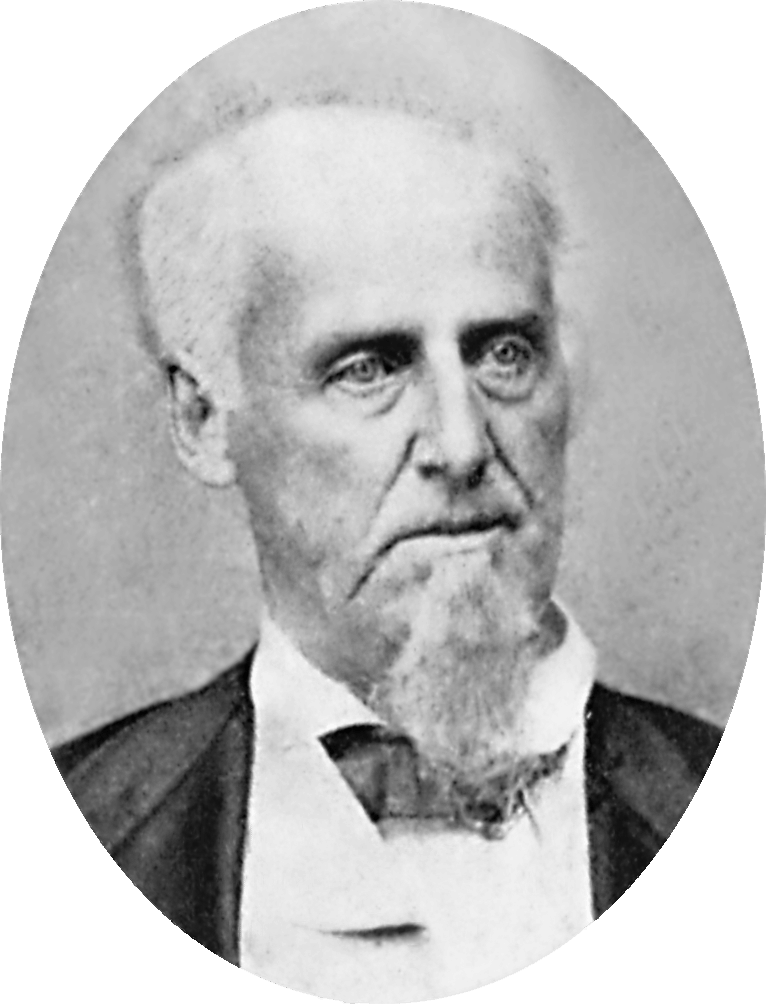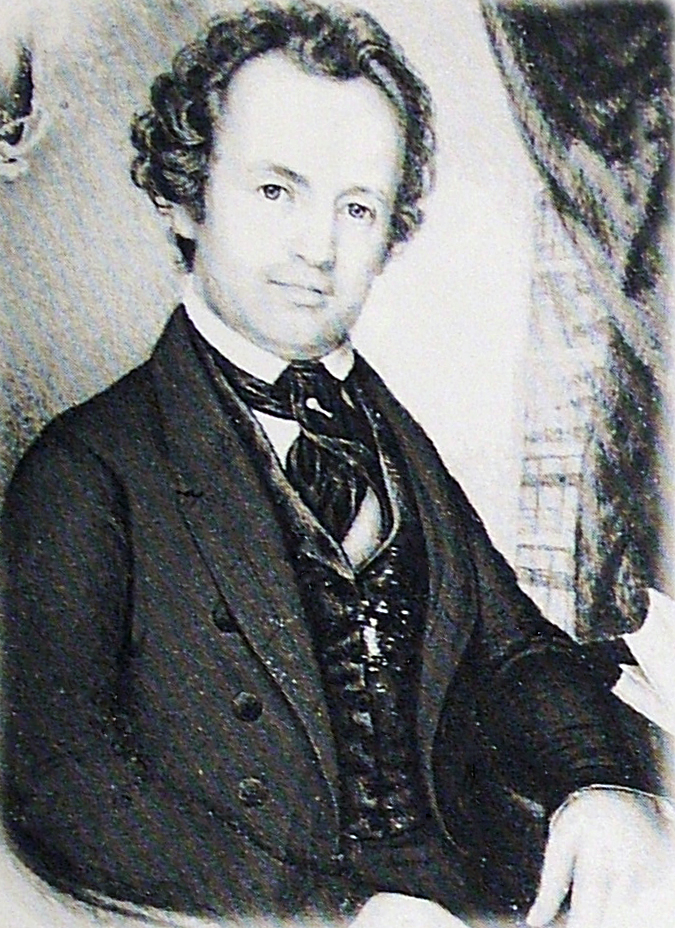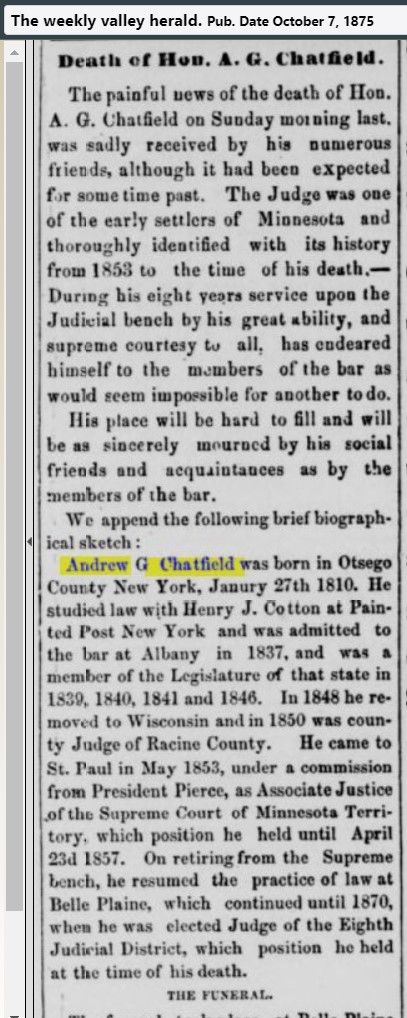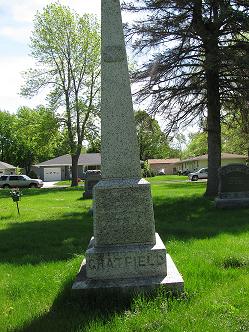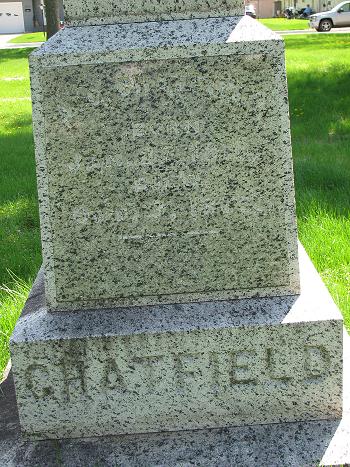Occupation: Lawyer, Associate Judge to Supreme Court, Member of New York State Assembly
Married: Jun 27, 1836, EUNICE ELECTA "EMMA" CLARK, adopted name BEEMAN, Addison Co., New York
One child:
1. Cecelia Annette "Celia" CHATFIELD
1837 - 1915
=========
Note: The town of Chatfield in Fillmore County, Minnesota is named for him.
=========
Andrew Gould Chatfield
The first Worshipful Master of Ancient Landmark Lodge was born at Butternuts, Otsego county, New York, January 27, 1810. His maternal grandfather was Jonathan Starr, a soldier in the Revolutionary war. His maternal grandmother was of the Ruggles family, among whose descendants are some of the most distinguished jurists of New York. His father, Enos Chatfield, owing to loss of property through a defective land title, was able to give his children but little aid in securing an education. Andrew, thrown upon his own resources, succeeded in working his way through the academy at Hamilton. He then took up the study of law in the office of Henry T. Colton at Painted Post, New York, and in 1833 was admitted to the bar. He soon after removed to Addison county, where he formed a partnership and was soon in the enjoyment of a lucrative practice.
He was married on June 27, 1836, to Eunice E. Beeman.
He served as a member of the New York assembly in 1838 and again in 1840. While a member of the assemble, he served with the late Samuel J. Tilden on the committee which had under consideration the "Anti-Rent" trouble.
In 1846 he was a member of the constitutional Convention of New York. In 1848 he removed to Southport, now Kenosha, Wisconsin, forming a partnership with Volney French, and soon acquired a lucrative practice. He received the Masonic degrees in Southport Lodge No. 7 in 1849, and subsequently became Master of the Lodge. In 1850 he was elected county judge of Racine county, but later resigned to resume the practice of law.
While in attendance upon the United States Supreme Court in Washington in 1853, he formed the acquaintance of Hon. H.H. Sibley, then serving as delegate in congress for the Territory of Minnesota. Judge Chatfield became so interested in the glowing accounts of the new territory related by the enthusiastic Sibley, that the later recommend him to President Pierce, who appointed him associate justice of the Supreme Court of the Territory. In June 1853, he removed to Minnesota and entered upon the discharge of his duties, which he continued until the close of his term, April 23, 1857.
He held the first term of court ever held in Fillmore county, then in the Second judicial district, and the hamlet where that court sat is now the thriving city of Chatfield – named at that time in honor of the Judge.
In 1854 Judge Chatfield located a claim in the Minnesota valley, which he afterwards laid out and named the village of Belle Plaine. At the close of his term on the supreme bench he resumed the practice of his profession until 1870, when he was elected judge of the Eighth judicial district, which office he continued to hold up to the time of his death.
His health becoming impaired, in the spring of 1873 he visited the Hot Springs of Arkansas in the hope of obtaining the needed relief, but without avail. His health continuing to decline, he died at Belle Plaine on October 3, 1875, his remains were laid to rest in the Episcopal church yard on Sunday, October 6. The Masonic burial services were held under the auspices of the Grand Lodge, Most Worshipful Grand Master Charles Griswold officiating, assisted by officers of the Grand Lodge. The pallbearers were Judge Wescott Eilkin, Gen. H.H. Sibley and Judge Aaron Goodrich of Saint Paul, Judge Brown of Shakopee, Hon. F.J. Whitlock of Belle Plaine, Hon. M.J. Severance of Mankato, and Judge Atwater and J.N. Shaw of Minneapolis. A large number of Masons were present, the Lodges at Belle Plaine, Shakopee, Carver, St. Peter, La Sueur, Mankato, St. Paul and Minneapolis being represented.
Judge Chatfield's death was widely noticed, and glowing tributes were paid to his worth as a lawyer, as a judge, a Mason and a man.
A.G. Chatfield was named in the charter of Ancient Landmark Lodge No. 5 as its first Worshipful Master. He held that office until the first Annual Communication of the Lodge in June 1854 – a period of six months. Bro. Chatfield's residence was at Mendota. The judicial district over which he presided was a large one, and he found very little time to devote to the Lodge. In fact he presided at but four meetings. Nevertheless, he ever maintained a keen interest in the Lodge's welfare.
Maj. T.M. Newson, in his "Pen Pictures," says of Judge Chatfield: "He was a straight, splendidly-built man, with a florid complexion and elegant address; very genial in his manners; indeed one might say he was a fine American gentleman, all of the olden time.' He was a judge of the finest purity of character, very careful and very honest, and very sincere, and very conscientious in his convictions of right."
And this was the first Worshipful Master of Ancient Landmark. May his successors ever strive to maintain the same lofty ideals.
Source: Ancient Landmark Golden Jubilee Book, Jan 7, 1904
=========
Occupation: Lawyer, Associate Judge to Supreme Court, Member of New York State Assembly
Married: Jun 27, 1836, EUNICE ELECTA "EMMA" CLARK, adopted name BEEMAN, Addison Co., New York
One child:
1. Cecelia Annette "Celia" CHATFIELD
1837 - 1915
=========
Note: The town of Chatfield in Fillmore County, Minnesota is named for him.
=========
Andrew Gould Chatfield
The first Worshipful Master of Ancient Landmark Lodge was born at Butternuts, Otsego county, New York, January 27, 1810. His maternal grandfather was Jonathan Starr, a soldier in the Revolutionary war. His maternal grandmother was of the Ruggles family, among whose descendants are some of the most distinguished jurists of New York. His father, Enos Chatfield, owing to loss of property through a defective land title, was able to give his children but little aid in securing an education. Andrew, thrown upon his own resources, succeeded in working his way through the academy at Hamilton. He then took up the study of law in the office of Henry T. Colton at Painted Post, New York, and in 1833 was admitted to the bar. He soon after removed to Addison county, where he formed a partnership and was soon in the enjoyment of a lucrative practice.
He was married on June 27, 1836, to Eunice E. Beeman.
He served as a member of the New York assembly in 1838 and again in 1840. While a member of the assemble, he served with the late Samuel J. Tilden on the committee which had under consideration the "Anti-Rent" trouble.
In 1846 he was a member of the constitutional Convention of New York. In 1848 he removed to Southport, now Kenosha, Wisconsin, forming a partnership with Volney French, and soon acquired a lucrative practice. He received the Masonic degrees in Southport Lodge No. 7 in 1849, and subsequently became Master of the Lodge. In 1850 he was elected county judge of Racine county, but later resigned to resume the practice of law.
While in attendance upon the United States Supreme Court in Washington in 1853, he formed the acquaintance of Hon. H.H. Sibley, then serving as delegate in congress for the Territory of Minnesota. Judge Chatfield became so interested in the glowing accounts of the new territory related by the enthusiastic Sibley, that the later recommend him to President Pierce, who appointed him associate justice of the Supreme Court of the Territory. In June 1853, he removed to Minnesota and entered upon the discharge of his duties, which he continued until the close of his term, April 23, 1857.
He held the first term of court ever held in Fillmore county, then in the Second judicial district, and the hamlet where that court sat is now the thriving city of Chatfield – named at that time in honor of the Judge.
In 1854 Judge Chatfield located a claim in the Minnesota valley, which he afterwards laid out and named the village of Belle Plaine. At the close of his term on the supreme bench he resumed the practice of his profession until 1870, when he was elected judge of the Eighth judicial district, which office he continued to hold up to the time of his death.
His health becoming impaired, in the spring of 1873 he visited the Hot Springs of Arkansas in the hope of obtaining the needed relief, but without avail. His health continuing to decline, he died at Belle Plaine on October 3, 1875, his remains were laid to rest in the Episcopal church yard on Sunday, October 6. The Masonic burial services were held under the auspices of the Grand Lodge, Most Worshipful Grand Master Charles Griswold officiating, assisted by officers of the Grand Lodge. The pallbearers were Judge Wescott Eilkin, Gen. H.H. Sibley and Judge Aaron Goodrich of Saint Paul, Judge Brown of Shakopee, Hon. F.J. Whitlock of Belle Plaine, Hon. M.J. Severance of Mankato, and Judge Atwater and J.N. Shaw of Minneapolis. A large number of Masons were present, the Lodges at Belle Plaine, Shakopee, Carver, St. Peter, La Sueur, Mankato, St. Paul and Minneapolis being represented.
Judge Chatfield's death was widely noticed, and glowing tributes were paid to his worth as a lawyer, as a judge, a Mason and a man.
A.G. Chatfield was named in the charter of Ancient Landmark Lodge No. 5 as its first Worshipful Master. He held that office until the first Annual Communication of the Lodge in June 1854 – a period of six months. Bro. Chatfield's residence was at Mendota. The judicial district over which he presided was a large one, and he found very little time to devote to the Lodge. In fact he presided at but four meetings. Nevertheless, he ever maintained a keen interest in the Lodge's welfare.
Maj. T.M. Newson, in his "Pen Pictures," says of Judge Chatfield: "He was a straight, splendidly-built man, with a florid complexion and elegant address; very genial in his manners; indeed one might say he was a fine American gentleman, all of the olden time.' He was a judge of the finest purity of character, very careful and very honest, and very sincere, and very conscientious in his convictions of right."
And this was the first Worshipful Master of Ancient Landmark. May his successors ever strive to maintain the same lofty ideals.
Source: Ancient Landmark Golden Jubilee Book, Jan 7, 1904
=========
Family Members
Advertisement
Explore more
Sponsored by Ancestry
Advertisement
